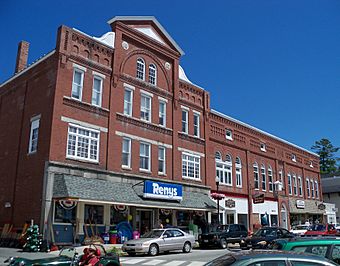Farmington Historic District (Farmington, Maine) facts for kids
|
Farmington Historic District
|
|
 |
|
| Lua error in Module:Location_map at line 420: attempt to index field 'wikibase' (a nil value). | |
| Location | Roughly bounded by High, Academy, Anson and Grove Sts., Farmington, Maine |
|---|---|
| Area | 85 acres (34 ha) |
| Built | 1875 |
| Architect | George M. Coombs; Edwin E. Lewis |
| Architectural style | Romanesque, Queen Anne, Italianate |
| NRHP reference No. | 94001551 |
Quick facts for kids Significant dates |
|
| Added to NRHP | January 20, 1995 |
| Boundary decrease | April 27, 2010 |
The Farmington Historic District is a special area in Farmington, Maine. It covers most of the town's main business center. People first settled Farmington in the 1770s. The town grew very quickly after 1838. This was when it became the shire town (or county seat) for Franklin County.
Another big growth spurt happened after a large fire in the 1880s. This central area has many of the town's oldest buildings. It shows off Farmington's most important shops and public buildings. The district is over 85 acres (34 ha) big and has more than 130 historic places. It was added to the National Register of Historic Places in 1995. This list helps protect important historical sites.
Contents
Discovering Farmington's Historic Heart
The Farmington Historic District mainly follows a part of Main Street. It stretches from Belcher Road in the north to where Main and Prescott Streets meet in the south. The district also includes High Street between Middle and Anson Streets. It goes east along Broadway, Court, and Orchards Streets too. This area contains almost all the old parts of the town's main business section. It does not include most of the University of Maine at Farmington campus. That campus is just south on High and Main Streets.
What Makes Farmington Special?
The very center of the business district is where Main Street and Broadway cross. The blocks to the north, south, and east of this spot are filled with brick buildings. These buildings were once shops and offices. The Franklin County Courthouse is one block north of this crossing. It sits between Church and Anson Streets. This courthouse is one of several buildings designed by George Coombs. He was a famous architect from Maine.
The areas north and east of these blocks have more homes. You can also find a few churches on High Street. More churches are near the southern end of the district on Main Street. Besides the county courthouse, other important public buildings are in the district. These include the town hall and the Cutler Memorial Library. The library is a beautiful building made in the early 1900s. It has a style called Beaux Arts.
A Walk Through History: Buildings and Styles
Many buildings in the district show different types of architecture. These styles include Romanesque, Queen Anne, and Italianate. Each style has its own special look.
Important Buildings to See
Greenacre is a grand old house high above Court Street. It is probably the best example of an Italianate mansion in town. An Italianate mansion often has tall windows and wide eaves.
"Fewacres" was the home of Jacob Abbott. He was a famous writer of children's books. This house was once part of the historic district. However, it was taken down around 2010.
There are also interesting churches in the district. One is the First Congregational Church, United Church of Christ. Another is the old Free Will Baptist Church. This building is now a garage at 219 Main Street.

